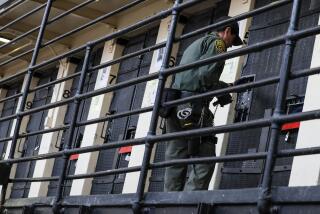State Court Urged to Overturn Ruling on Juries, Death Penalty
- Share via
The California Supreme Court was urged Wednesday to overturn a far-reaching ruling that state prosecutors say gives juries too much discretion in deciding when to impose the death penalty.
State Deputy Atty. Gen. Jay M. Bloom said the 1985 ruling conflicts with U.S. Supreme Court mandates limiting juror discretion and fails to provide adequate guidelines for reaching verdicts in capital cases.
“Under the ruling, there are no standards for determining when death is appropriate,” Bloom told the justices in oral argument in Los Angeles. “Juries can go off in any direction they want to, basing their decisions on the defendant’s race or ethnic group or even whether they like him or not.”
On the other side, Monica Knox, state chief assistant public defender, backed the 1985 ruling and argued that jurors should have sufficient discretion to fairly weigh mitigating factors favoring the defendant.
She said the death verdict imposed on the defendant in the case before the court should be reversed because the jury was prevented from considering evidence about his unhappy family life, severe sexual problems and other aspects of his personal background.
The defendant “staked his life on winning mercy from the jury,” Knox said. “But jurors were told to put aside their personal feelings and not make a ruling from the heart. . . . A death verdict was virtually guaranteed.”
Wednesday’s hearing marked the 49th capital case to come before the court since three new appointees of Gov. George Deukmejian took office after the defeat of former Chief Justice Rose Elizabeth Bird and two other justices in the November election.
The new and more conservative court, now led by Chief Justice Malcolm M. Lucas, has completed oral argument on a wide range of significant issues related to the death penalty. When the cases are decided, the new court could sweep aside some of the most controversial capital punishment rulings made under Bird.
The new court’s decisions could eventually result in death judgments being affirmed in dozens of the 199 capital cases now pending before the justices, if, as widely predicted, they rule on the side of state prosecutors on major questions. Since capital punishment was restored in 1977, the court has upheld only five of the 70 death penalty cases it has reviewed.
Among others, prosecutors have asked the new court to overturn or modify past rulings that:
- Required instructing jurors that before they can return a death verdict they must specifically find that defendants in murder cases intended to kill their victims.
- Invalidated a provision of the 1978 death penalty initiative requiring that juries be told the governor can commute a sentence of life in prison, thus allowing parole. The court said the instruction was misleading because jurors were not told that the governor also can commute sentences of death.
- Upheld a requirement that a death sentence must be reversed whenever there has been a “substantial” procedural error in the penalty phase of a trial. Prosecutors want the court to require reversal only when there is a “reasonable probability” that the error affected the outcome--the less-strict standard already applied in ordinary criminal cases.
The case argued Wednesday involved another Bird court ruling that, if reversed, also could ease the way for executions in a substantial number of cases.
At issue is the validity of a death sentence for Albert Greenwood Brown, a parolee convicted of the rape and murder of 15-year-old Susan Jordan in Riverside in 1980.
In December, 1985, the Bird court upheld Brown’s conviction but overturned the death sentence on grounds that the jury had been improperly instructed not to be swayed by “mere sympathy” in deciding whether to impose death or life in prison.
The justices also held that jurors retain the discretion of rendering a death verdict only when they believe it is “appropriate.” The justices found that jurors still had that discretion, even though the 1978 law says juries should be instructed they “shall” impose death whenever aggravating factors (such as a defendant’s prior criminal record) outweigh any mitigating factors (such as the absence of a criminal record).
The court said that in the future, trial judges must make it clear to jurors that despite the wording of the law, jurors are free to reject the death sentence whenever any “relevant evidence or observation” makes the death penalty “inappropriate.”
The justices said further that they would “pass no judgment” on previous cases where the instruction at issue was given. Each case would be examined on its own merits to see whether judges and attorneys made it clear that jurors retained discretion.
In dissent, Lucas, then an associate justice, expressed considerable concern about the “ominous” implications of the decision on the 170 capital cases then pending. “We would place an intolerable and unjustified burden upon the judicial system were we to reverse 170 death judgments merely because of possible confusion regarding the meaning of standardized jury instructions,” Lucas said.
State Atty. Gen. John K. Van de Kamp took the case to the U.S. Supreme Court, urging that the ruling be overturned. In January, the high court granted prosecutors a partial victory by holding that jurors could be told not to be swayed by “mere sympathy”--but sent the case back to the California court to resolve the remaining issues.
More to Read
Sign up for Essential California
The most important California stories and recommendations in your inbox every morning.
You may occasionally receive promotional content from the Los Angeles Times.










